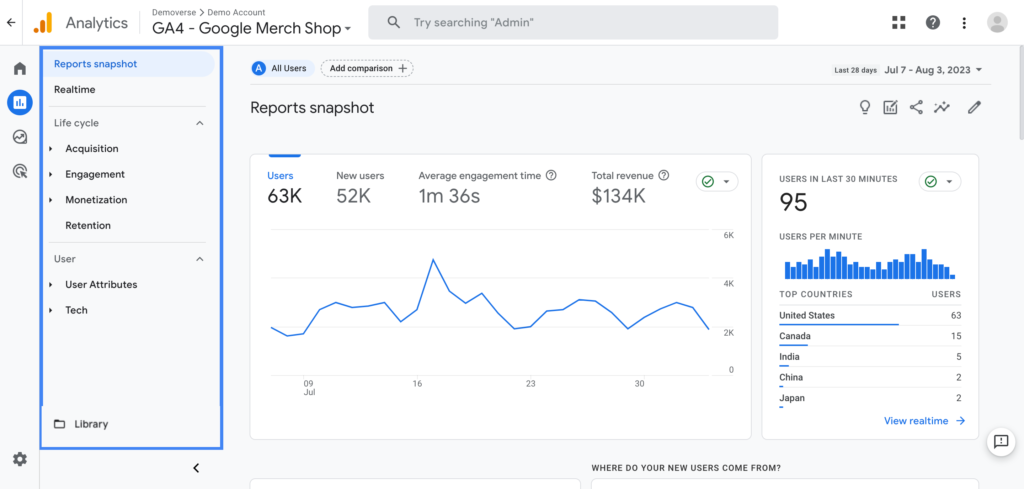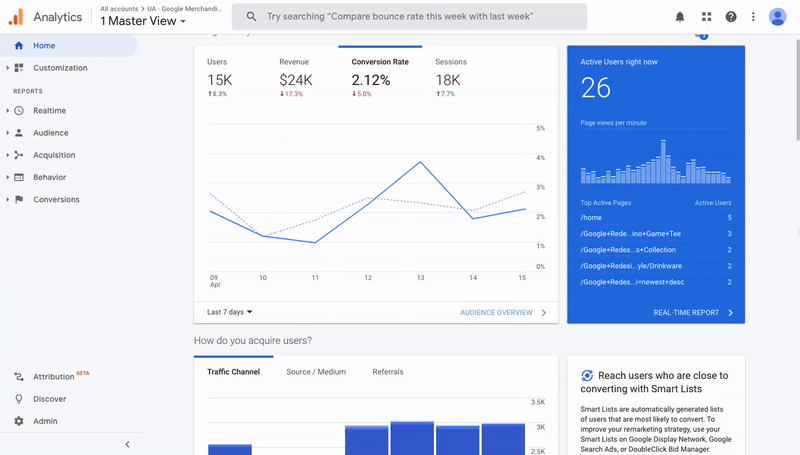Google Analytics is very powerful in transforming how to handle and grow your WordPress blog. This allows the user to understand behavior and sources of traffic and performance of content that gives valuable insights on just how to guide strategy and maximize reach into your blog. We will discuss in this tutorial the ways you can use Google Analytics for optimizing your WordPress blog.
Understanding Google Analytics

Google Analytics shows general information about what is happening with your website and how your visitors are engaging with it. Success for bloggers comes down to which tool you want to use, and the most important measure or success would be with some scopes on how to go forward from there. There are so many different data points that you could analyze to make better decisions about user experience and content optimization.
Key Features:
- Real-time Reporting: Know who’s coming and when.
- Audience Insights: Collect all demographics, interests, and behaviors of your audience.
- Acquisition Reports: Where are the people coming from?
- Behavior Reports: How do people interact with the content that you’re generating?
- Conversion Tracking: Track your conversion rates for your goals and objectives.
Understanding these tools is the first key to unlocking the full potential of Google Analytics for your WordPress blog.
Setting Up Google Analytics on Your WordPress Blog
To start using Google Analytics, you need to set up an account and connect it to your WordPress blog. Here’s how:
Create a Google Analytics Account:
- Go to your Google Analytics page and sign up with your Google account.
- Click on “Admin” then “Create Account” to create a new property for your blog.
Add Tracking Code to WordPress:
- After creating your account, Google Analytics will provide you with a tracking code.
- Install a plugin like “MonsterInsights” or “GA Google Analytics” in WordPress.
- Enter the tracking code into the plugin settings to start collecting data.
Verify Your Setup:
- Check if Google Analytics accepts data by searching for the “Real-Time” report in your Google Analytics dashboard.
By these actions, you are ensuring that you have Google Analytics set up correctly and ready to give you valuable insights.
Also Read: 10 Common WordPress Blog Mistakes and How to Fix Them?
Key Metrics to Track in Google Analytics

Monitor specific metrics that measure the success of your blog. Some of the most important metrics to keep track of are:
- Uniques: The number of different users visiting your blog.
- Bounce Rate: Bounce Rate Percentage of visitors who leave immediately after visiting one page only.
- Average Session Duration: Average Session Duration Average time spent by visitors while at your site.
- Pages per Session: Pages per Session Average pages viewed per session.
| Metric | Description | Importance |
|---|---|---|
| Pageviews | Total pages viewed | Measures overall traffic |
| Unique Visitors | Distinct users | Indicates blog reach |
| Bounce Rate | Single-page visits | Shows engagement level |
| Average Session Duration | Time spent on site | Reflects user interest |
| Pages per Session | Pages viewed per visit | Assesses content attractiveness |
How to Analyze Traffic Sources?
Knowing your traffic sources can enable you to improve your marketing strategies. Google Analytics has many in-depth reports of traffic sources:
- Direct Traffic: Visitors who type your blog URL directly.
- Organic Search: Traffic from search engines like Google.
- Referral Traffic: Visitors coming from other websites.
- Social Media Traffic: Users coming from social media platforms.
How to Access Traffic Sources:
- From the “Acquisition” section in Google Analytics.
- Click “All Traffic,” then click on “Source/Medium” to have a detailed view of your traffic sources.
Checking your sources will then allow you to see which channels are specifically effective at generating traffic for your blog.
Monitoring User Behavior on Your Blog
User behavior tracking is vital for understanding how visitors interact with your blog. Google Analytics offers various reports to monitor behavior:
- Behavior Flow: Visualizes the path users take through your blog.
- Site Content: Shows performance of individual pages.
- Site Speed: Provides insights into your blog’s loading times.
Behavior Flow Example:
| Stage | Percentage of Users | Action |
|---|---|---|
| Homepage | 60% | Entry point |
| Blog Posts | 25% | Content engagement |
| Contact Page | 10% | Conversion attempt |
| Exit | 5% | Leaving the site |
Optimizing Content Based on Analytics
Content optimization involves using data to enhance your blog posts. Focus on the following:
- Identify High-Performing Content: Use the “Site Content” report to find which posts attract the most traffic.
- Analyze User Engagement: Check metrics like average session duration and bounce rate for insights.
- Update Underperforming Content: Revise posts with high bounce rates or low engagement to improve performance.
Content Optimization Tips:
- Incorporate relevant keywords.
- Enhance readability with engaging formats.
- Add internal links to related content.
Also Read: How to Use SEO to Grow Your WordPress Blog Audience in 2024?
Setting Up Goals and Conversions
Goals help you track specific actions users take on your blog. Setting up goals in Google Analytics allows you to measure conversions:
Define Your Goals:
- These involve the submission of contacts, subscribing to newsletters or other information, and buying products.
Setup Goals in Google Analytics:
- Go to “Admin” and then “Goals”. Then click on create new goals.
- Select goal type: destination, duration, or event.
Example Goals:
| Goal Type | Description | Conversion Rate |
|---|---|---|
| Destination | Reaching a specific page (e.g., Thank You) | Measures successful completions |
| Duration | Spending more than a set time on site | Indicates engagement level |
| Event | Clicking a specific button or link | Tracks interactions |
Using Google Analytics Reports for SEO Improvement
Google Analytics reports can significantly impact your SEO strategy:
Identify High-Traffic Keywords:
- Use the “Acquisition” reports to see which search queries drive traffic.
Analyze Content Performance:
- Review which pages are ranking well and driving traffic.
Optimize Based on Data:
- Adjust your SEO strategies based on insights from traffic and behavior reports.
SEO Improvement Tips:
- Focus on optimizing high-traffic pages.
- Implement keyword-rich content based on search queries.
- Improve site structure and internal linking.
Integrating Google Analytics with WordPress Plugins
Several WordPress plugins can enhance Google Analytics functionality:
- MonsterInsights: It provides full analytics directly within WordPress.
- Google Site Kit: It integrates Google Analytics, Search Console, and AdSense.
- GA Google Analytics: Simplifies tracking code integration.
Benefits of Plugins:
- Streamlined setup and management.
- Access to additional features and reports.
- Easier integration with other WordPress tools.
Common Mistakes to Avoid with Google Analytics
Avoid these common pitfalls to ensure accurate data and effective use of Google Analytics:
- Ignoring Data Sampling: Large data sets may be sampled, affecting accuracy.
- Not Setting Up Goals: Without goals, you can’t track conversions effectively.
- Neglecting Regular Reviews: Regularly review reports to stay updated on performance.
- Overlooking Mobile Analytics: Ensure the data includes mobile traffic insights.
Avoid Mistakes Checklist:
| Mistake | Solution |
|---|---|
| Data Sampling | Use unsampled data for detailed reports |
| Not Setting Up Goals | Define and implement goals |
| Neglecting Regular Reviews | Schedule regular data reviews |
| Overlooking Mobile Analytics | Include mobile traffic in analysis |
Conclusion
Google Analytics is such an important tool you will use in growing your WordPress blog. Now, let’s set up some tracking, track some important metrics, analyze sources of traffic, then tailor content so that you have better data-driven decisions about your blog, and avoid doing these common mistakes. Always check frequently for more analytics to stay ahead of this competitive game of blogging.
Must Read: How to Create a Viral Post on Your WordPress Blog?
FAQs
What is Google Analytics used for?
Google Analytics tracks and analyzes website data. You can know the kind of behavior that users are taking place on your website, sources of traffic, and even the performance of your content.
How do I set up Google Analytics on my WordPress blog?
Create a Google Analytics account, obtain the tracking code, and integrate it with your WordPress blog using a WordPress plugin.
What are the key metrics to track in Google Analytics?
Essential metrics include pageviews, unique visitors, bounce rate, average session duration, and pages per session.
How can I use Google Analytics to enhance my SEO?
Track where your traffic is coming from, what content is currently working, and which keywords are ranking best to refine your SEO strategy.
What are the most common mistakes a person should avoid with Google Analytics?
Do not overlook data sampling, set no goals, fail to hold regular reviews, and also let pass mobile analytics.



